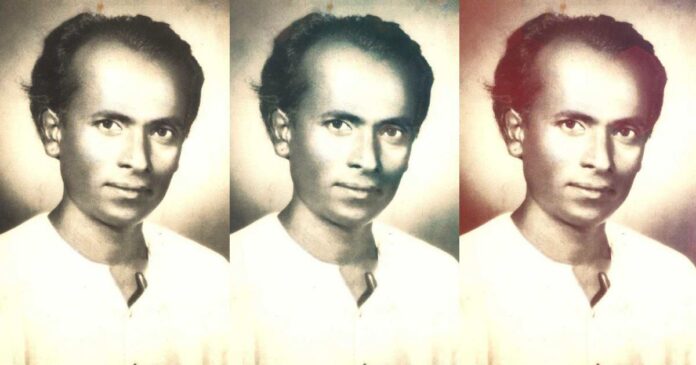Annabhau Sathe (1920-1969) was a giant of Indian literature. He was the pioneer of Dalit literature in Marathi. He wrote thirty-five novels, scores of short stories, powadas (ballads), and tamashas (folk theatre of Maharashtra). He is rightfully revered as sahityaratna (jewel of literature) and lok-shahir (people’s bard) and hero of Maharashtra’s statehood movement. But these epithets barely do him justice. He was first and foremost a worker and a Comrade. He had set out to destroy capitalism and the caste system. The pen and the drum were his weapons. Revolution was his dream – a world where all would prosper and none would be exploited, considered impure or inferior.
The project to appropriate his legacy, strip it bare of all revolutionary messages is well underway. He is being projected, not as an anti-caste icon, but as a ‘Matang’ icon and ironically – a “rival” to Ambedkar. Even worse- as a deity to be worshipped, not emulated.
He wrote from his lived experiences not just as a member of the industrial working class of colonial Bombay, but also as an ‘untouchable’ and a marginal worker doing every sort of menial job to survive. His protagonists always come from such marginal and oppressed backgrounds as himself. They express the pain of the oppressed but always wage a fight against oppressors. They win some battles and lose others but the point is that they always fight.
In “Smashanatil Sona” (Graveyard Gold) Bhima, unemployed and desperate, fends off hungry jackals to get gold teeth from corpses. In “Barbadya Kanjari” the eponymous hero from the labour camps of Mumbai defies his caste elders. The convict “Sultan” fights his jailors for the human right to a full meal. ‘Fakira’ the hero of his most popular and renowned novel rebels against the British empire.
In his tamashas, like “Akalechi Goshta” (Tale of Wit) the traditional village simpleton becomes a satirical critic of the establishment. Peasants outsmart village elites. Milkmaids are no longer the object of double-meaning humour but the bearers of revolutionary messages.

In one famous song, Daulatichya-Raja, he exhorts peasants to –
“uproot the weeds of capitalism … fire slingshots at imperialism.”
In another, he declares:
“Thus spoke Bhimrao (Dr. Ambedkar)
The zealots have tortured us, the wealthy have squeezed us dry.
Change this world with a hammer blow!”
By extolling the bravery of the defenders of Stalingrad in a powada, he instantly relates them with Shivaji’s peasant guerrillas.
From the depths of his writings, Annabhau exposes the social systems that rob the poor, and emphasizes the essential unity of workers in the struggle against those systems – cutting across caste, religion, gender and nationality.
Recovering Annabhau’s Ideas
His contribution was largely ignored by the mainstream, just like Babasaheb Ambedkar’s. For decades grassroots activists, bards and publications preserved his memory. As political parties increasingly felt the need to consolidate Matang (Annabhau’s caste) votes the elite cultural apparatus grudgingly acknowledged Annabhau’s existence as a literary icon – but nothing more.
Statues and memorials are being built or renovated. Roads and government schemes are being named and re-named after him. However, his ideas are being silently buried.
The project to appropriate his legacy, strip it bare of all revolutionary messages is well underway. He is being projected, not as an anti-caste icon, but as a ‘Matang’ icon and ironically – a “rival” to Ambedkar. Even worse- as a deity to be worshipped, not emulated.
In one ceremony in 2016, BJP’s Devendra Fadnavis, then CM of Maharashtra, sporting a sunflower (colour of Matang pride) turban, called Annabhau the ‘deity of bards’. Steering clear of mentioning Annabhau’s working-class roots or anti-caste views the CM emphasized his caste identity before moving on to standard vote-grabbing rhetoric. Flex banners commemorating his Jayanti increasingly leave out ‘Comrade’ from his string of honorifics. At his memorial in the heart of Pune, a fresco depicting his communist legacy has now been effectively concealed behind a temple-style canopy. A ‘YouTube’ search reveals fewer videos on his works than Matang pride songs and ‘DJ dances’.
On the other hand, these facts also indicate that people would like to hear about Annabhau. For more than ten years now, we have been performing his original songs in slums, on streets, and at his memorial. The response of many ordinary people is heartening. It reminds us that the fight is far from lost. It is still possible to restore the true content of Annabhau’s writings in the minds of the people. Hope lies in action.
Three decades of neoliberal globalisation and a neo-fascist government have ensured that the suffering of Annabhau’s protagonists – workers, peasants, farm labour, women, Dalits, nomads, and Adivasis has seldom been worse. Migrant labourers walking to their villages during the COVID-19 lock-down are not much unlike the young Annabhau who walked hundreds of kilometers from his famine-ridden village to Mumbai. Maybe they will agree with his call to unite. To reach their hearts and minds is the challenge confronting those who dream as Annabhau dreamt. Comrade Annabhau Sathe has furnished the tools. How will we use them?
Nishchay Mhatre ([email protected]) on behalf of Kafila – cultural wing of the Pune based activist group Lokayat (lokayat.org.in)



